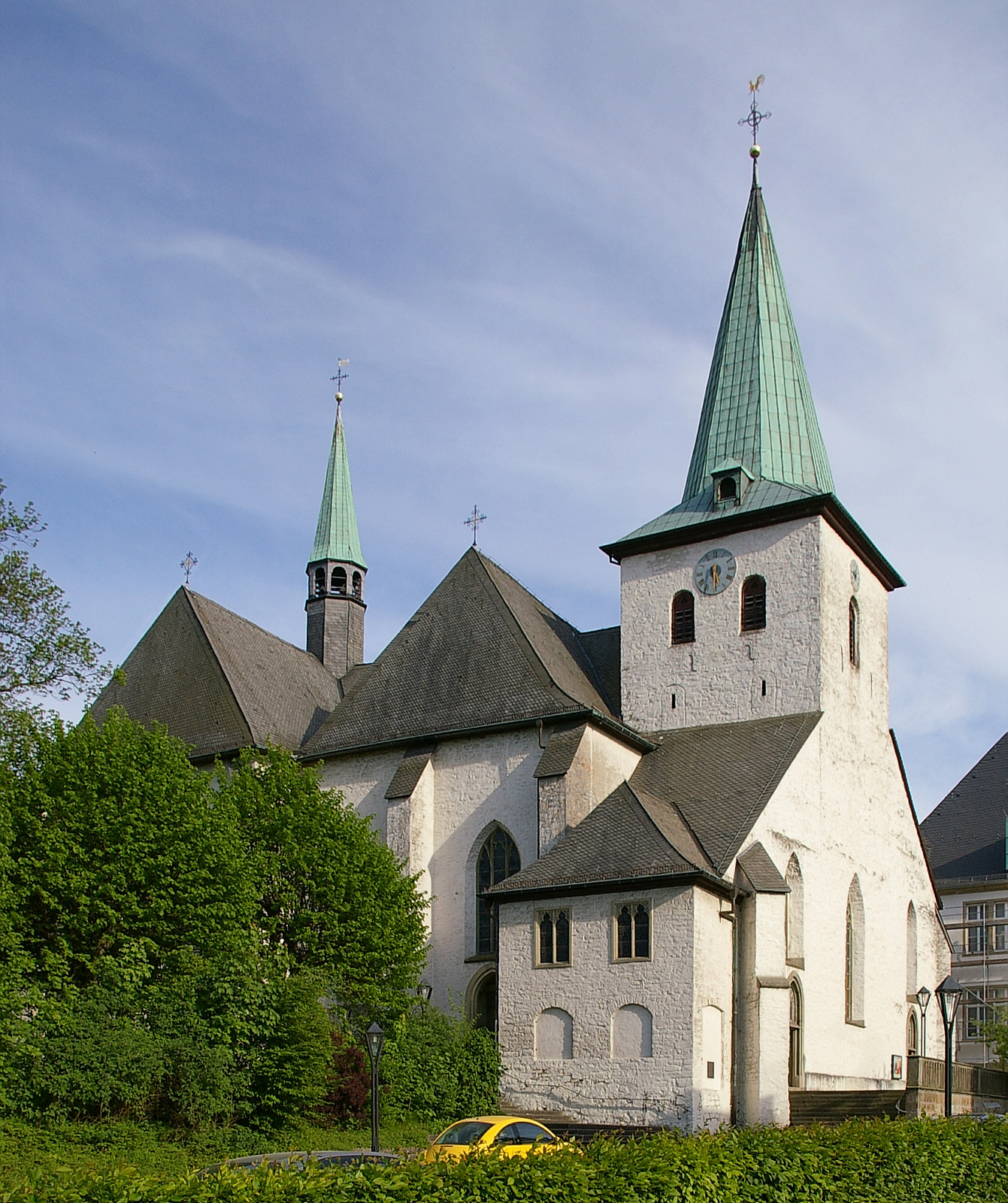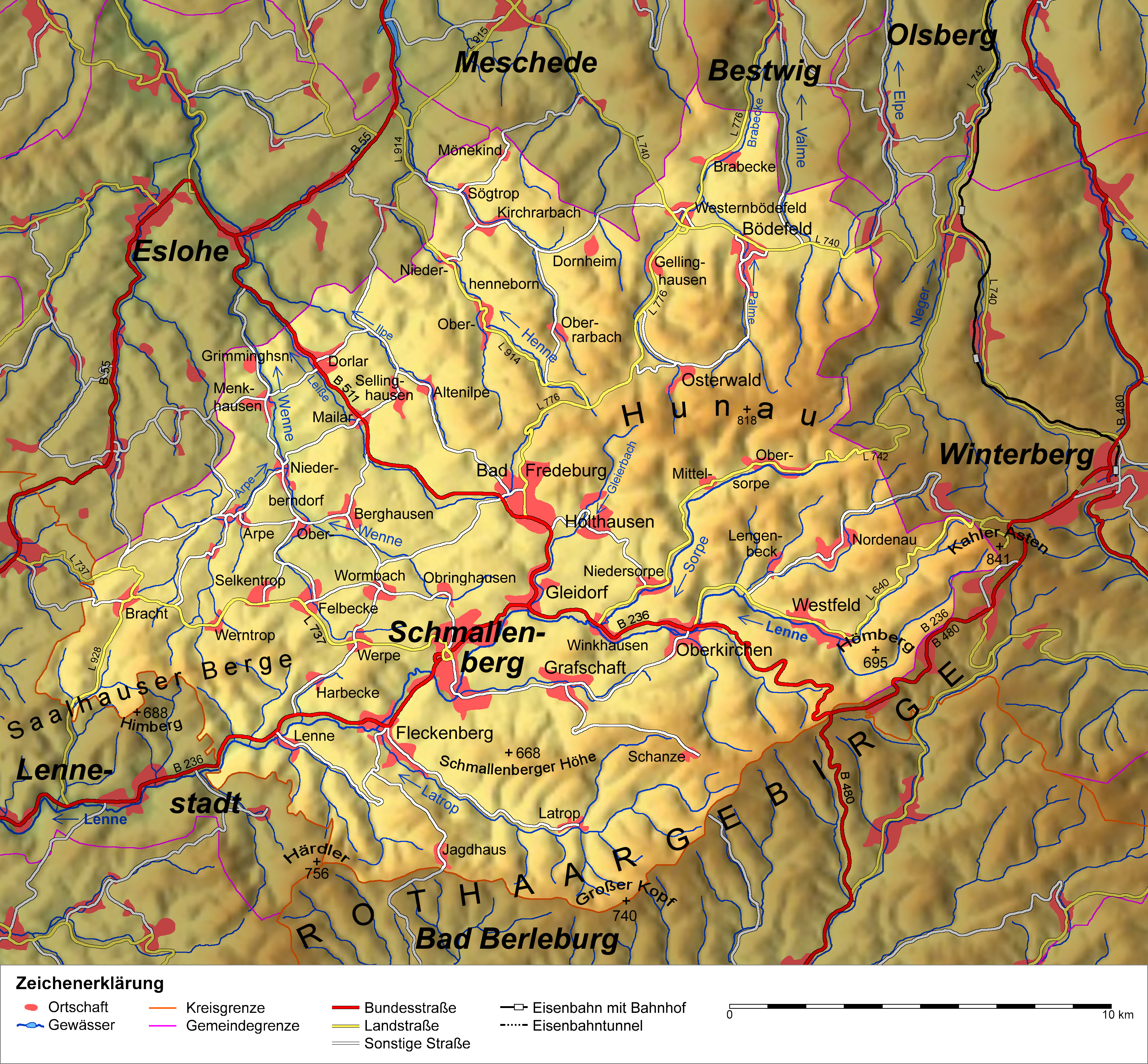|
High Sauerland
Hochsauerlandkreis (meaning “High Sauerland District” in German) is a Kreis (district) in the east of North Rhine-Westphalia, Germany. Neighboring districts are Soest, Paderborn, Höxter, Waldeck-Frankenberg, Siegen-Wittgenstein, Olpe, Märkischer Kreis. The district is named “High Sauerland” because two of the highest mountains of the Sauerland mountainous landscape, Langenberg and Kahler Asten are in its territory. With 2,766 ft / 843 m (Langenberg) and 2,762 ft / 842 m (Kahler Asten) these are also the highest mountains of North Rhine-Westphalia. History The district was established in 1975 in the reorganization of the districts in North Rhine-Westphalia by merging the previous districts Arnsberg, Brilon and Meschede. Geography Geographically the district covers a big part of the Sauerland mountains, including the highest and third highest elevation – the Langenberg near Olsberg with 2,766 ft / 843 m, and the better known Kahler Asten with ... [...More Info...] [...Related Items...] OR: [Wikipedia] [Google] [Baidu] |
Meschede
Meschede () is a town in the Hochsauerland district, in North Rhine-Westphalia, Germany. It is the capital of the district Hochsauerlandkreis. Education One of the five branches of South Westphalia University of Applied Sciences (also: Fachhochschule Südwestfalen (FH SWF)) is located here. Geography Meschede is situated in the Ruhr valley, near to the Hennesee, south of the nature-park Arnsberger Wald. Major towns in the vicinity of Meschede are Paderborn (51 km), Kassel (85 km), Siegen (57 km), Hagen, Dortmund (60 km) and Hamm (49 km). Neighbouring municipalities * Arnsberg * Bestwig * Eslohe * Schmallenberg * Sundern * Warstein Division of the town After the local government reforms of 1975 Meschede consists of these districts and villages: History Meschede was founded as a settlement around a convent, the ''Walpurgis-Stift'' , in the 10th century. In 1572, it became a member of the Hanseatic League. In the 18th century, many inh ... [...More Info...] [...Related Items...] OR: [Wikipedia] [Google] [Baidu] |
Arnsberg
Arnsberg (; wep, Arensperg) is a town in the Hochsauerland county, in the German state of North Rhine-Westphalia. It is the location of the Regierungsbezirk Arnsberg administration and one of the three local administration offices of the Hochsauerlandkreis district. Geography Location Arnsberg is located in the north-east of the Sauerland in the Ruhr river valley. The river Ruhr meanders around the south of the old town of Arnsberg. The town is nearly completely encircled by forest, and the nature park ''Arnsberger Wald'' lies to the north". Arnsberg is connected by Federal Motorway 46 (Autobahn 46) Brilon in the east and (using the Federal Motorway 445) Werl in the west. It is also connected by several railroad stations, which provide a connection to the major city Dortmund and the Ruhrgebiet. There is also a regional airport, located in the city district of Vosswinkel, which is exclusively used for small private aircraft. The municipal territory spans a distance of up t ... [...More Info...] [...Related Items...] OR: [Wikipedia] [Google] [Baidu] |
Abbey Bergkloster
An abbey is a type of monastery used by members of a religious order under the governance of an abbot or abbess. Abbeys provide a complex of buildings and land for religious activities, work, and housing of Christians, Christian monks and nuns. The concept of the abbey has developed over many centuries from the early monastic ways of religious men and women where they would live isolated from the lay community about them. Religious life in an abbey may be monastic. An abbey may be the home of an enclosed religious order or may be open to visitors. The layout of the church and associated buildings of an abbey often follows a set plan determined by the founding religious order. Abbeys are often self-sufficient while using any abundance of produce or skill to provide care to the poor and needy, refuge to the persecuted, or education to the young. Some abbeys offer accommodation to people who are seeking retreat (spiritual), spiritual retreat. There are many famous abbeys across t ... [...More Info...] [...Related Items...] OR: [Wikipedia] [Google] [Baidu] |
Franz Hoffmeister
Franz Hoffmeister (22 March 1898 – 27 March 1943) was a German Roman Catholic priest and the founder of the Sauerländer Heimatbund and Festspiele Balver Höhle. Life Hoffmeister was born in Ramsbeck. He was consecrated to a Roman Catholic priest by bishop Hähling von Lanzenauer in 1924. References In German *Theodor Pröpper, ''Franz Hoffmeister. Leben und Werk'', Verlag Bonifatius Druckerei, Paderborn 1949 1898 births 1943 deaths People from Hochsauerlandkreis Westphalia culture 20th-century German Roman Catholic priests {{Germany-RC-clergy-stub ... [...More Info...] [...Related Items...] OR: [Wikipedia] [Google] [Baidu] |
West Lothian
West Lothian ( sco, Wast Lowden; gd, Lodainn an Iar) is one of the 32 council areas of Scotland, and was one of its shires of Scotland, historic counties. The county was called Linlithgowshire until 1925. The historic county was bounded geographically by the River Avon, Falkirk, Avon to the west and the River Almond, Lothian, Almond to the east. The modern council area occupies a larger area than the historic county. It was reshaped following local government reforms in 1975: some areas in the west were transferred to Falkirk (council area), Falkirk; some areas in the east were transferred to Edinburgh; and some areas that had formerly been part of in Midlothian were added to West Lothian. West Lothian lies on the southern shore of the Firth of Forth and is predominantly rural, though there were extensive coal, iron, and shale oil mining operations in the 19th and 20th centuries. These created distinctive red-spoil heaps (locally known as "bing (mining), bings") throughout the ... [...More Info...] [...Related Items...] OR: [Wikipedia] [Google] [Baidu] |
Twin Towns And Sister Cities
A sister city or a twin town relationship is a form of legal or social agreement between two geographically and politically distinct localities for the purpose of promoting cultural and commercial ties. While there are early examples of international links between municipalities akin to what are known as sister cities or twin towns today dating back to the 9th century, the modern concept was first established and adopted worldwide during World War II. Origins of the modern concept The modern concept of town twinning has its roots in the Second World War. More specifically, it was inspired by the bombing of Coventry on 14 November 1940, known as the Coventry Blitz. First conceived by the then Mayor of Coventry, Alfred Robert Grindlay, culminating in his renowned telegram to the people of Stalingrad (now Volgograd) in 1942, the idea emerged as a way of establishing solidarity links between cities in allied countries that went through similar devastating events. The comradeship ... [...More Info...] [...Related Items...] OR: [Wikipedia] [Google] [Baidu] |
Eslohe
Eslohe is a municipality in the Hochsauerland district, in North Rhine-Westphalia, Germany. Geography Eslohe is situated approximately 25 km south-west of Meschede. Neighbouring municipalities * Finnentrop * Lennestadt * Meschede * Schmallenberg * Sundern Division of the town After the local government reforms of 1975 Eslohe consists of the following districts: Twin towns * Kisbér (Hungary) Notable people * Georg Milbradt Georg Milbradt (born 23 February 1945) is a German politician of the Christian Democratic Union (CDU) who served as Minister-President of Saxony from 2002 to 2008. Early life Milbradt was born in Eslohe. His family originally was from Wągrowie ... (born 1945), politician (CDU) References External links Official site Hochsauerlandkreis {{Hochsauerlandkreis-geo-stub ... [...More Info...] [...Related Items...] OR: [Wikipedia] [Google] [Baidu] |
Bestwig
Bestwig is a municipality in the Hochsauerland district, in North Rhine-Westphalia, Germany. Geography Bestwig is situated on the river Ruhr, approx. 10 km east of Meschede. It lies on the German Autobahn A 46. Bestwig has a railway station, connecting the town through local trains to Dortmund Hauptbahnhof, Winterberg and Hagen Hauptbahnhof. Neighbouring municipalities * Olsberg * Schmallenberg * Meschede * Rüthen * Warstein Subdivisions Since 2009, the municipality is officially divided into 6 so-called ''Ortschaften'', each containing of one to five villages (Ortsteile''). Economy Bestwig, surrounded by many acres of pine tree forests, is a centre of Christmas tree production. Tourism, however, is the most important source of income. The Sauerland forests are popular among hikers and, in winter, skiing is possible. Twin towns Bestwig has no official partnership with another town, but has close to ties to Niederorschel (Thuringia, Germany) and Niederwiesa (Saxo ... [...More Info...] [...Related Items...] OR: [Wikipedia] [Google] [Baidu] |
Sundern
Sundern is a town in the Hochsauerland district, in North Rhine-Westphalia, Germany. The name Sundern is common in Westphalia, as it means "ground given away for private usage" in the Westphalian dialect. Geography Sundern is situated approximately south-west of Arnsberg. Around Sundern extends the nature park ''Homert'' which attracts tourists, many from the Netherlands. Winter tourism is also substantial, primarily in the municipality ''Wildewiese'' with its skiing area. The Sorpesee, an artificial lake, is used by watersportsmen, campers and fishermen. Neighbouring municipalities Division of the town Sundern consists of 16 ''Ortschaften'' (subdivisions): §3, Stadt Sundern * [...More Info...] [...Related Items...] OR: [Wikipedia] [Google] [Baidu] |
Schmallenberg
Schmallenberg ( Westphalian: ''Smalmereg'') is a town and a climatic health resort in the High Sauerland District, Germany. By area, it is the third biggest of all cities and towns of the state of North Rhine-Westphalia and the second biggest of the region of Westphalia. With small Schmallenberg central town and the rural Bad Fredeburg Kneipp health resort the town has two urban settlements. Additionally, 82 villages and hamlets belong to the town's territory. Also being called “the Schmallenberg Sauerland”, the Town of Schmallenberg is famous for its total of fiveStadt Schmallenberg: Kurort health resorts and nineSchmallenberger Sauerland: Golddörfer Schmallenberg und Esloh villages which have been awarded gold for their beauty in the nationwide “” contest. Geography Schmallenberg is located in the southeast of the Sauerland mountainous landscape. The Rothaar Mountains make up a part of the town's territory. Through the central town flows the river Lenne. It is sit ... [...More Info...] [...Related Items...] OR: [Wikipedia] [Google] [Baidu] |
Medebach
Medebach () is a town in the Hochsauerland district, in North Rhine-Westphalia, Germany. Geography Medebach is situated approximately east of Winterberg, south-west of Korbach and north of Marburg. Neighbouring municipalities * Korbach * Lichtenfels, Hesse, Lichtenfels * Willingen * Winterberg Division of the town Besides, the town center of Medebach, the municipality consists of the following districts, formerly independent villages: * ''with Roninghausen'' * ''with Wissinghausen'' * * * * * * * International relations Medebach is town twinning, twinned with * Locminé (France) * Worbis (Germany) History The town was first mentioned in a document in 1144. It belonged to the Hanseatic League. Medebach and its district Oberschledorn entered the international news in September 2007 during the 2007 bomb plot in Germany, when three Islamic terrorists, two Germans and a Turk, were arrested there. They had received training in Pakistan and were about to build ... [...More Info...] [...Related Items...] OR: [Wikipedia] [Google] [Baidu] |
Marsberg
Marsberg () is a town in the Hochsauerland district, in North Rhine-Westphalia, Germany. History Although its origins are obscure, Marsberg was a prospering town by the 13th century (it was even minting coins). It was a free city until 1807, when it was incorporated into the Kingdom of Westphalia, until 1813. After two years of independent government, it was added to Prussia in 1815. Geography It is situated on the river Diemel, approx. 20 km east of Brilon and 30 km south of Paderborn. Neighbouring municipalities * Bad Arolsen * Bad Wünnenberg * Brilon * Diemelsee * Diemelstadt * Lichtenau * Warburg Town division Marsberg consists of the following 17 districts: * Beringhausen * Borntosten * Bredelar * Canstein * Erlinghausen * Essentho * Giershagen * Heddinghausen * Helminghausen * Leitmar * Meerhof * Niedermarsberg * Obermarsberg * Oesdorf * Padberg * Udorf * Westheim International relations Marsberg is twinned with: * Lillers (France) Notable people ... [...More Info...] [...Related Items...] OR: [Wikipedia] [Google] [Baidu] |



.jpg)



